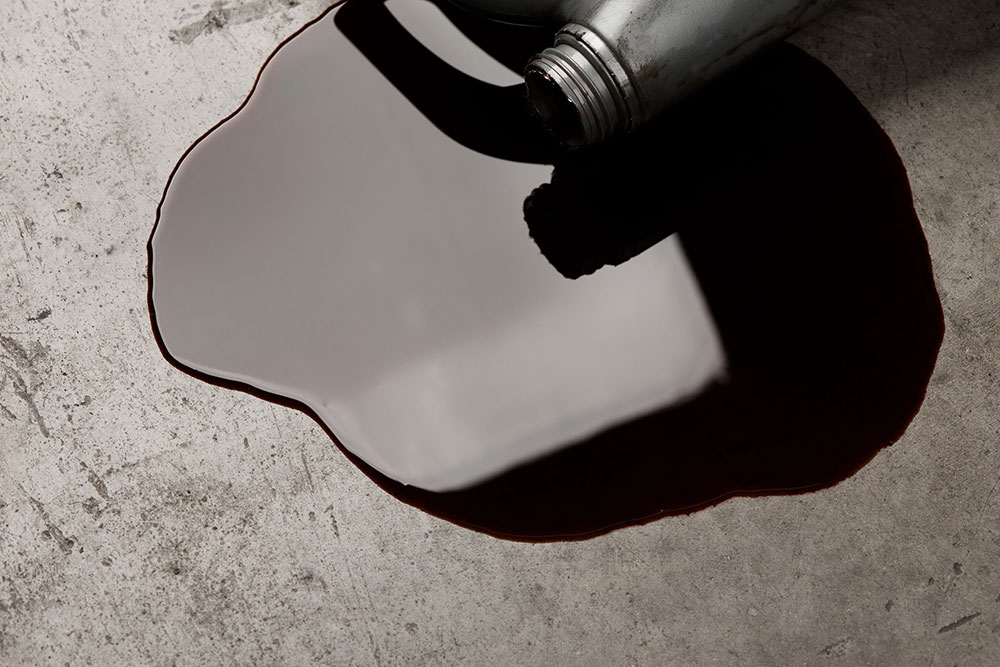First Aid for Oil Spills on Epoxy Floors

So, it’s late Sunday afternoon and you’re just packing up your garage after a bit of tinkering with the Beast. In a rush to get to that nice cold one, you knock over an oil container and, in seconds, your epoxy floor looks like something Greenpeace should be concerned about. What are you going to do with oil spills on epoxy floors?
First step: Stay calm. An epoxy floor is much easier to clean up than a bare concrete floor, and if you’re maintaining it well, cleaning up an oil spill should be a relatively straightforward affair (even if you have to wait just a little longer for that coldie).
Second step: Respond quickly. As with all first aid situations, you’ll need to move fast if you want to save the day. But fear not. We’re about to lay out your Epoxy Floor First Aid strategy for oil spills.
Your epoxy floor first aid kit
Here’s a list of things you’ll need on hand to handle any mishaps.
- A couple of foam mops with spare mop heads, or some soft, highly absorbent cleaning cloths
- Gentle detergent or soap (like dishwashing liquid)
- A soft broom or scrubbing brush
- A couple of buckets.
If there’s a risk you may have a larger spill, you may even want to consider buying a proper spill kit that includes absorbent powder or filler.
An ounce of prevention…
Preparation is paramount if you’re going to respond quickly and calmly to any oil spills on epoxy floors. If you look after your floor well in the first place, with regular cleaning and maintenance, you’ll already be on the front foot if the worst should happen. Here are a few things you should be doing regularly.
Basic maintenance – regularly sweep your floor using things like floor dusters or a soft broom. Clean up any stubborn stains as soon as possible, with some hot water and detergent. You shouldn’t need to mop too often, and when you do, avoid chemicals or harsh soaps. Dishwashing liquid should be just fine. Hosing is okay, but only occasionally.
Protect surfaces – use felt pads, coasters, or some other protective material between your furnishings and the floor. (Think heavy metal shelves with coarse footings or exposed metal that might dent, scratch or stain your floors. Even stools or chairs can mark your floors, damaging the finish over time.)
Protect others – Check with your local Council or other authority about how to dispose of chemicals. If you’re cleaning up an oil, paint or other chemical spill, putting in the normal garbage could be potentially hazardous to you or other people (flammable items can explode if left in an enclosed container like a bin, especially if it’s in the sun), or the environment (e.g. leaching from land fill into water tables). Most Councils and local authorities will have a special collection point for these sorts of items, so get in touch with them before anything happens and find out what special processes you may need to follow in the aftermath of cleaning up a spill).
Be your own spill response team
First things first: Clear up the spill. Mop up the fluid with a soft foam mop or cleaning cloths. You’re not going to be using these ever again, so put them in a garbage bag or nearby bin for proper disposal. (You’ll already have got those instructions from your Council).
With a clean mop or soft cloth, use warm, soapy water to break down the remnants of what’s left. You may need to change the water (and the cloths) a couple of times to get rid of any last residues. Finish up with a clean water rinse, and dry – again, using soft cloths or a clean mop head.
(Bonus tip: Consider keeping one mop with changeable heads for initial clean ups, and another clean one for final mops and rinses. Do the same with your buckets. This way, you’ll need fewer mop-head changes and you won’t accidentally transfer any chemical residues after a cleanup.)
Spill kits for larger spills
If spills happen often, or you’re worried you may be at risk of a large spill, talk to us about getting a proper spill response kit that suits your needs. These often come with absorbent powders that you sprinkle over the spill. This lets you scrape up the spill, rather than having to wrangle multiple mops and buckets. It also helps you manage a larger spill more quickly.
Epoxy floor = crisis averted
The beauty and benefit of a good quality epoxy floor comes into its own in spill situations. Faced with an oil spill on a standard concrete floor, you’d have to use heavy-duty cleaners, industrial degreasers, and a whole lot of harsh scrubbing to clean the spill and get that stain out before it took up permanent residence. With an epoxy floor, your work is more than half done, and you won’t have to put off that cold one for so long after all.

